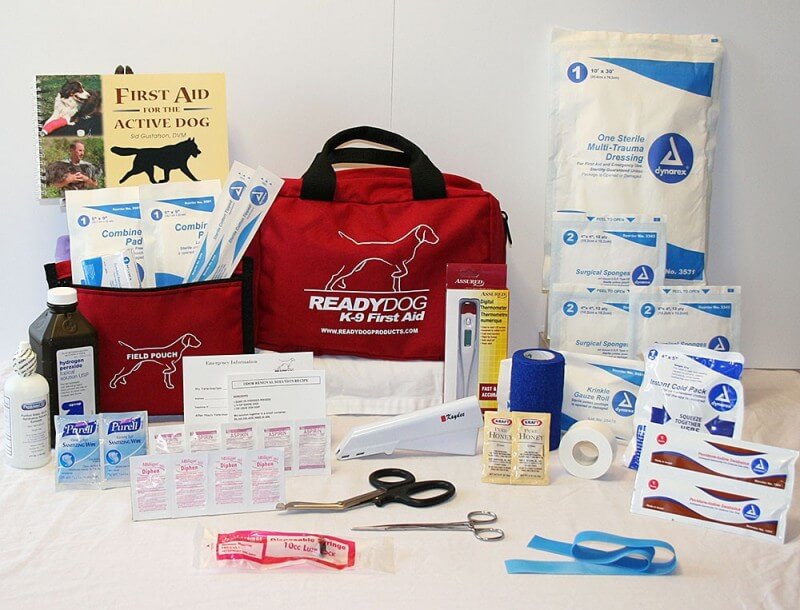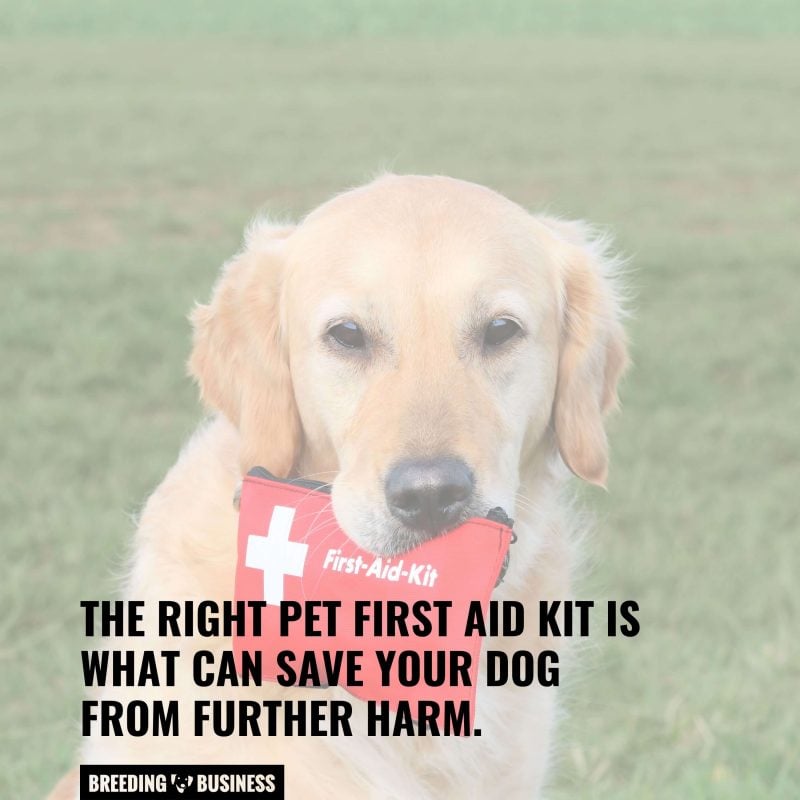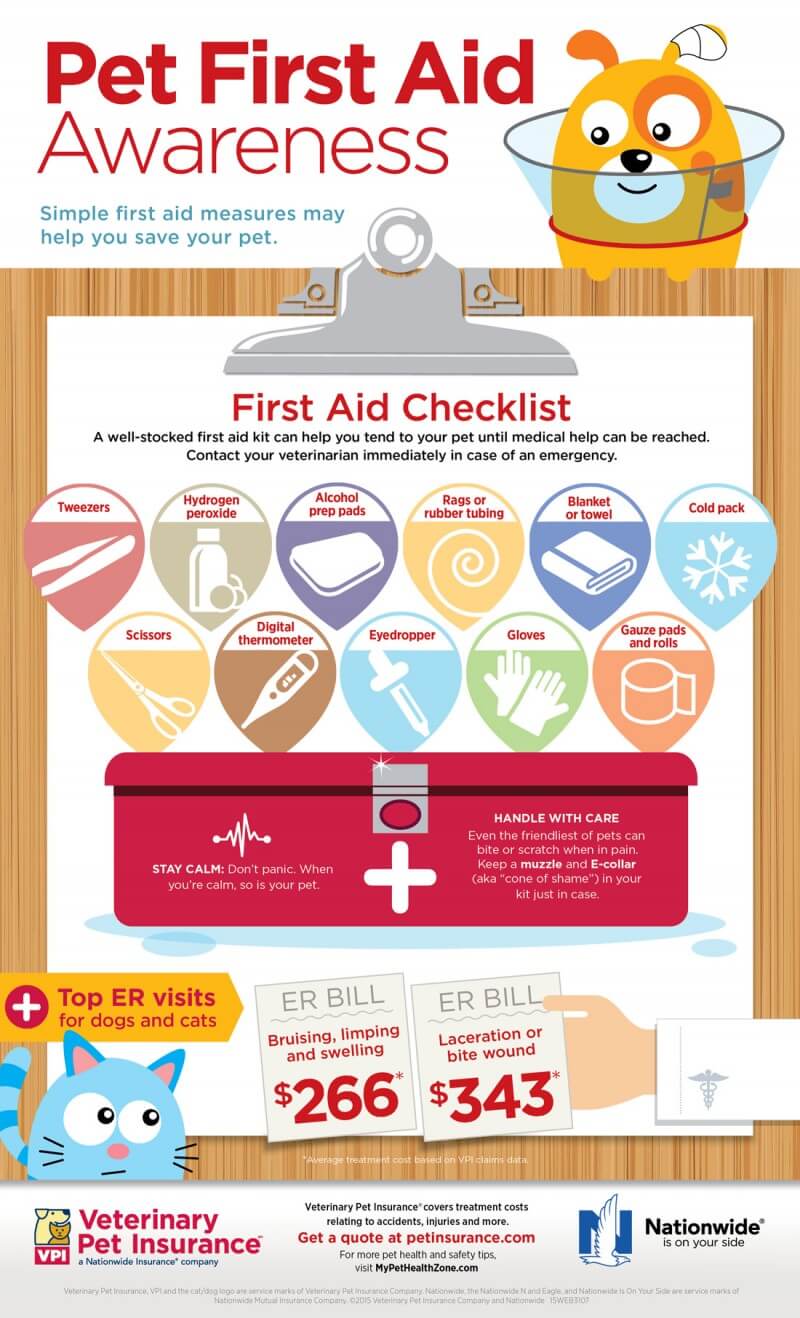Most people don’t have a dog first aid kit and they’re wrong. Dogs are active pets, they go on walks, they run, they play, and sometimes they hurt themselves a little. Nothing worth a visit to the vet, but often worth being cleaned up and looked after. This is where having a first aid kit for dogs comes to play.
Dog first aid kits consist of all the small pieces of equipment, accessories, and products needed to take care of modest injuries. Bruises, superficial cuts, and lesions, injured paws and pads, a lot of everyday little wounds need your attention while often not being life-threatening. A comprehensive emergency dog kit will have you fully prepared to give the necessary care to your pooch.
In short, a first aid kit for dog or human should include simple items that perform a simple task:
- removal equipment to get rid of external things (tweezers, tick removal tool, etc.)
- handling equipment to make your life easier (thermometer, scissors, etc.)
- gentle and strong disinfectants to clean up any wound, scratch or cut
- bandages and dressings to protect the area from the environment
- painkillers and antibiotics to relieve your dog from some inevitable pain
When listed that way, it all looks very clear but then you need to be prepared for a wound on your dog’s paw as well as a high fever or an eye infection. Obviously, you want to call your vet and make sure you can handle it yourself. But then, you must vary your products, tools, and levels of strength for various scenarios.
Are you feeling a little lost now? Let me shed some light into what you actually need in a comprehensive dog first aid kit.

Summary, Prices and Links
Below is a list of the must-have items for your dog first aid kit, what they are used for and a link to see the best rated Amazon product. Below the table is a very detailed description of each of these items and products.
| Item | Useful to… | Best Product |
|---|---|---|
| Disinfectants | ||
| Sterile Eye Wash | cleanse irritated eyes | Tomlyn OpticlearTM |
| Ear Wash | regularly dissolve dirt | Zymox Ear Cleanser |
| Antiseptic Wipes | clean up a wound | Pet MD Chlorhexidine |
| Painkillers and Antibiotics | ||
| Antibiotic Ointment | heal abrasions, skin dermatitis, allergies and minor cuts | Zymox Topical |
| Vet-Prescribed Pain Relief | control pain, fever and joint inflammation | Nutri-Vet® K-9 Aspirin |
| Diphenhydramine | alleviate of multiple allergy symptoms | Benadryl |
| Bandages and Dressings | ||
| Gauze Dressings | protect the wound from further harm | JJ Gauze Pads |
| Surgical Tape | compress and hold the dressing in place | 3M Transpore Clear |
| Self-Adhesive Bandages | keep minor cuts protected from the environment | Self-Adherent Stretch |
| Removal Tools | ||
| First Aid Tweezers | remove small splinters from your dog’s paw | Carson Lighted Tweezers |
| Tick Removal Tool | efficiently grab and pull the whole tick | Tick Twister |
| Scissors | remove excess hair and cut gauze dressings | Pet Scissors Kits |
| Useful Equipment | ||
| Thermometer & Lubricant | monitor your dog’s body temperature | Clinical Digital Thermometer |
| Box of Cotton Wool | clean the wounded or infected area | Organic Cotton Balls |
| Muzzle | restrain the dog from licking and biting its own wounds | Baskerville Ultra Muzzle |
| Elizabethan Collar | prevent your dog from scratching its own face | Comfy Cone |
| Exam Gloves | stay clean while inspecting and treating an injury | Liberty Glove Duraskin |
If this is too much for you, there are also ready to use dog first aid kits available online.
Disinfectants For Dogs
In a kit, products are what will clean up an area and with bandages and dressings, they really depend on what type of area and wound you are facing. Some very light scratches can be disinfected using salted warm water, while others need to be properly taken care of with one of the below products.
Sterile Eye Wash
A common dog eye wash or sterile buffered saline can be appropriately applied in a dog’s eye to cleanse and rinse the eye. On the other hand, these drops won’t be of assistance for an infected and inflamed eye. These would require medical cleaning that only a veterinary practice can thoroughly perform.
Ear Wash
Dog owners and dog breeders often forget about their dogs’ ears, we somewhat think that they magically self-clean. While this is partly right, dog ears can be extremely sensitive and you must examine them every few weeks to spot any onset of infection.
Inspecting a dog’s ear only takes a few seconds and can save your pet a lot of trouble later on in life. Just pull the ears, look for excess dirt, irritated patches, unusual color, parasites and obviously, infections.
Antiseptic Wipes
Antiseptic wipes are the most convenient way to protect your dog against harmful bacterias, germs and stamp out some viruses. For example, chlorhexidine pet wipes tend to be very gentle on the skin so you want to use them regularly depending on the wound’s severity. They are great for superficial irritations, scratches, and lesions.
For example, we sometimes notice a reddish patch somewhere on our dog’s body and usually do nothing beside monitoring. From now on, just wipe the area!
An important packing tip: be sure to get a re-sealable pack to not have to bin it after you finished using it. You could also buy an antiseptic solution with some cotton, but wipes are just so convenient it’s hard to go against.
Painkillers and Antibiotics for Dogs
Pain relief is something we don’t think about until we see our dogs being feverish, sleepy and unusually inactive. There are several ways to make your dog feel better even when the pain or discomfort is real.
Antibiotic Ointment
The nonprescription triple antibiotic ointment contains bacitracin, neomycin sulfate and polymyxin B. These active compounds will help your dog heal abrasions, skin dermatitis, allergies, and minor cuts. It is a great go-to topical ointment for dogs whenever you want to do more than just clean an area.
The disadvantage when using a dog antibiotic cream is that you must prevent your dog from licking it right after (ie. half an hour after). And as we’re all dog owners, we know how hard that is. Having a foldable Elizabethan Collar is definitely ideal especially because you will apply this ointment several time a day, over several days.
Vet-Prescribed Pain Relief
Painkillers for dogs and non-steroidal anti-inflammatory drugs (NSAIDs) are available over-the-counter but you also need a vet-prescribe pain relief, in case the pain becomes too strong and you cannot get your companion to the vet just yet.
So many options are available, and it’s confusing, I know. But please, stick to dog painkillers and completely forget about giving a human drug. Some are actually lethal, other require a very specific dosage, while some have painful side effects. So besides Aspirin that is an okay painkiller for dogs, everything else you should avoid.
Great vet-prescribed pain relief solutions for dogs include:
- Codeine for dogs — a strong (narcotic) drug that is used to relieve strong pains
- Rimadyl for dogs — reduces pain and treats inflammation due to arthritis and hip dysplasia
- Deramaxx for dogs — control pain and inflammation, specifically with osteoarthritis
- Previcox for dogs — inhibits chemicals responsible for pain, inflammation and fever
Any vet will make your dog go through a blood test before prescribing any of these. But once you have it, your vet will explain how it works and when it should be given.
Diphenhydramine (aka Benadryl)
Benadryl is the branded name while diphenhydramine the actual active molecule’s name. It is an over-the-counter medicine used for the treatment of allergies in both people and dogs.
Oral diphenhydramine is not FDA-approved for use in veterinary medicine; however, it is a commonly accepted practice to use this medication in dogs and cats.
1-800 Pet Meds
Results are great for anybody who tried it: no more watery eyes, runny nose… Diphenhydramine gets rid of many allergy symptoms!

Bandages and Dressings
Perhaps the most obvious group of items out of all. Bandages and dressings, along with sticky surgical tape are required to protect vulnerable areas of the dog’s skin and bone from further harm. Placing a tight dressing also helps with bruising.
A dressing is designed to be in direct contact with the wound, as distinguished from a bandage, which is most often used to hold a dressing in place. Many modern dressings are self-adhesive.
Wikipedia
An injured animal requires cleaning up and disinfection first; and then protection from the elements. These include the dog licking and biting itself, but also bacterias and germs present around your home and outside.
What Bandages and Dressings Should I Have In My Dog First Aid Kit?
Once you start browsing for these, you’ll realize there are gazillions options: self-adhesive and crepe bandages, open-weave bandages, non-adhesive absorbent dressings, open wound dressings, sterile absorbent gauzes, etc. I stopped here but there are even more. Don’t get me started with the shapes, sizes and various packagings.
People often over-complicate things so let’s make them simple and choose versatile bandages and dressings.
Gauze Dressings
By far the most typical wound dressing is the straightforward gauze bandage: they’re multipurpose, and can be applied onto so many different sorts of wounds. Additionally, they are available in a multitude of styles, shapes and sizes to satisfy a wide-range of needs.
The purpose of these gauze dressings is to shield the damaged spot from filth, germs, harmful bacteria and other outside invaders. Dressings ensure a moist environment around the wound while letting external air disperse and circulate to speed up the healing process.
Surgical Tape
Holding a dressing onto a wound requires tape, but not any type of tape. Surgical sticky tape will hold any dressing on a wound thanks to its hypoallergenic adhesive. It is designed to stick to the skin, dressing and underlying layers while being removed without harming the skin.
Surgical tape is breathable meaning the healing and cicatrisation will follow its optimal course!
Self-Adhesive Bandages
Similar to plasters we used younger, self-adhesive bandages are great to fix small problems. They come in very small sizes all the way to huge squares. The surface includes two distinct areas: the non-adhesive central part that will be in direct contact with the wound, and the sticky adhesive all around that will be stuck to the dog’s skin.
Some are waterproof, others aren’t but generally, you’ll use these for minor injuries. Bigger wounds will require a proper compressed dressing held with surgical tape.

Removal Tools
Removal tools and accessories are what you usually need urgently so make sure it’s part of your dog first aid kit. For example, you see a splinter in your dog’s paw, or a tick on your pet’s body. Scissors are also useful to get rid of excess coat around the wounded area, they allow for better cleaning.
First Aid Tweezers
A must-have in any home! Whether you need to remove a small splinter from your dog’s paw, or dirt from a wound, tweezers are just what you need. If your dog is adventurous, it will be used within weeks or months. No doubt.
Some tweezers boast an ingenious design with magnifying lens attached so you can carry small and detailed work with ease.
Tick Removal Tool
The best method still to date is to use a Tick Twister — it’s the favorite tick removal tool for most veterinarians! Ticks are biting in your dog’s skin and remain attached for as long as possible, infecting your dog with various parasites and bacterias. Tick removal follows 3 simple steps with the O’Tom Tick Twister:
- An easy way to grab most of the tick’s body
- A twisting motion to detach the mouth from the dog’s body
- A straight pull to completely remove the tick without leaving the tick’s rostrum in the skin
In a comparison study of four different tick-removal devices, published in the Veterinary Record (2006, 159, 526-529), the Tick Twister® was compared with surgical forceps, a pen-tweezer device, and a tempered steel tool (slit and traction action).
The Tick Twister® proved to be significantly better than the other devices for the time required to remove the tick, the ease with which the tick was grabbed, the force needed to extract the tick, the reaction of the animal, and the condition of the tick’s mouthparts.
Ticktwister.co.uk
Scissors
In any dog first aid kit you should find scissors. They are just an all-round great tool but make sure they are blunt-ended (also called bull nose) to avoid unexpected accidents.
Scissors are used when cutting tape and dressings but also to remove excess hair in the area you are currently treating. It’s easier when you can see what you are touching and your dog’s hair will grow back shortly after so no need to feel bad.

Useful Equipment
A dog first aid kit means must contains some necessary items that just get used even when there is no emergency. Like after a vet visit, or to prevent your dog from licking its wounds, etc.
Thermometer & Lubricant
These are so useful in so many cases to monitor your dog’s temperature:
- when you suspect a fever
- when you soothe allergies’ symptoms
- after a vet visit
- post-surgery
A dog’s normal body temperature is around 101 to 102.5 degrees Fahrenheit, or 38.3 to 39.2 degrees Celsius. Scientists struggle to come up with a better solution than using an anal thermometer to take the most accurate measure of the dog’s temperature. So yep, you’re stuck with it, sorry!
To go with it, you will need some quality lubricant that is gentle on the surface, if I may put it that way.
Box of Cotton Wool
This is just the definition of usefulness. A box of cotton wool in a first aid kit for dogs can play multiple roles. Put some in your dog’s ears while bathing to avoid water going in. Put some antiseptic solution on it to clean up your dog’s wound. Use salted water and a cotton wool to clean up your dog’s pads. And so on.
Obviously, they can the form of pads, tissue-like sheets, balls, etc. As long as you have some, you’re good to go!
Muzzle
In uncomfortable and painful situations, a dog can react unexpectedly and at times, aggressively. Not necessarily towards you but they can try to get rid of the dressing you installed, or lick the topical ointment you applied on a wound, etc.
A well-fitted muzzle is a great way to prevent them from hurting themselves while being a totally gentle solution. It’s not hurting them in the slightest and restrains them safely!
Elizabethan Collar
Often referred to as a pet cone, this type of collar is worn as a protective medical device. It’s simply here to prevent your dog from licking or biting its paws and body, or scratching its head. It does one job, and does it very well.
A muzzle can be used to but for longer periods of time a pet cone is favored since it allows the dog to drink and properly breathe even at night. A muzzle is smaller and less annoying but slightly more restrictive.
Exam Gloves
Whether you are examining your dog’s injury or getting your hands dirty for whatever reason, having some exam gloves always comes handy. Just be sure to get gloves that do not contain any allergy causing rubber and go for nitrile gloves rather than latex. Some dogs (and humans) are very sensitive to donning powder and natural rubber latex.
Conclusion
Such a long article and thank you if you stayed with me until here! As you have seen here, having a comprehensive dog first aid kit means preparing for as many situations as possible.
We’ve listed each item and explained why it matters. You can either buy items separately and build your own first aid kit for dogs, or you can decide to buy an already-made one. These made one are usually incomplete (they’re saving money by forgetting about items!) but will do fine for most situations.

2 comments on “The Perfect Dog First Aid Kit — What’s In It?”
Everybody should have their dog first aid kit ready because accidents happen. Make sure your first aid kit for dogs include equipment and products that will help with a wounded paw as well as with a simple eye infection.
[…] of insect bites that may cause skin conditions or reactions. I keep preventative medicines such as Benadryl on […]